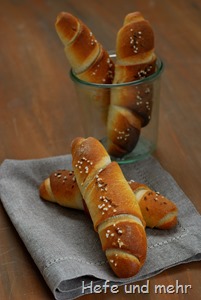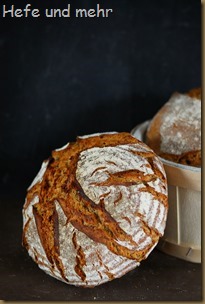 This Farmers bread is the right bread for every one who is looking for a rustic bread for busy weeknights. It uses the same principle like the summer evening bread: boiled sourdouhg. To enhance the sourdough flavour I allowed the rye sourdough to ripen for a long time. This can be troublesome in busy weeks but boiled sourdough has one major advantage: It can be prepared one week in advance. So all you have to do is making it on a not so busy day (maybe at the weekend?) and keep it in the fridge until needed. Then you have a “ready to use” sourdough at hand every day of a week.
This Farmers bread is the right bread for every one who is looking for a rustic bread for busy weeknights. It uses the same principle like the summer evening bread: boiled sourdouhg. To enhance the sourdough flavour I allowed the rye sourdough to ripen for a long time. This can be troublesome in busy weeks but boiled sourdough has one major advantage: It can be prepared one week in advance. So all you have to do is making it on a not so busy day (maybe at the weekend?) and keep it in the fridge until needed. Then you have a “ready to use” sourdough at hand every day of a week.
In this case it is used for flavour and tiny tangy flavour in this bread which contains about 70% Spelt and 30% rye. Such a rustic bread gain a lot from a tiny amount of bread spice added to the dough. I opted for a small amount which only underlines the complex flavours of the long and cold fermentation. But of course you are free to adjust this amount to your taste: use more for a stronger flavour or leave it away if you do not like it. The mixture can be varied as well. I normally opt for same parts of fennel, caraway and coriander seeds. Continue reading





 Sometimes the spontaneously created breads are the best. Breads that base on the actual stock in the ktichen cupboards can turn out to be new favourites, just like this potato rolls. And this caraway seed bread follows this route.
Sometimes the spontaneously created breads are the best. Breads that base on the actual stock in the ktichen cupboards can turn out to be new favourites, just like this potato rolls. And this caraway seed bread follows this route.


